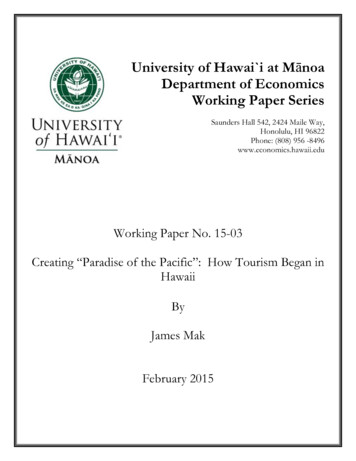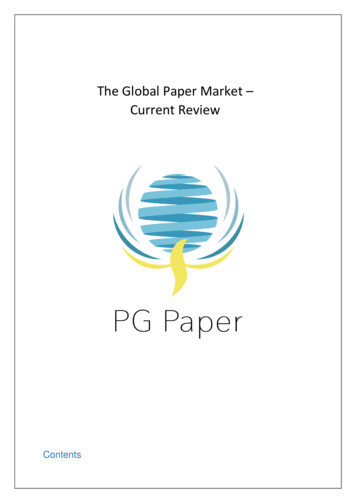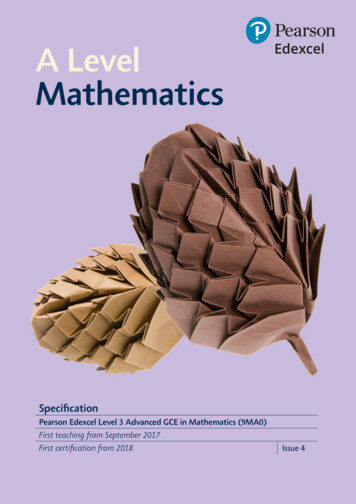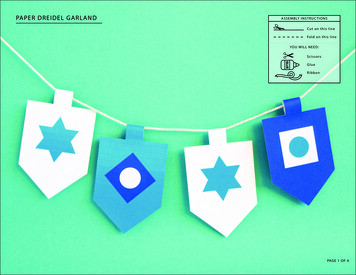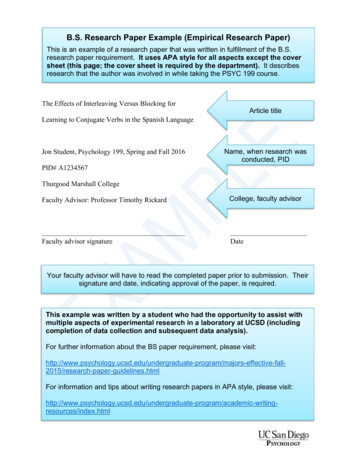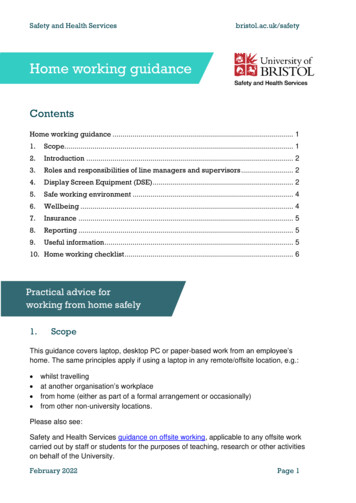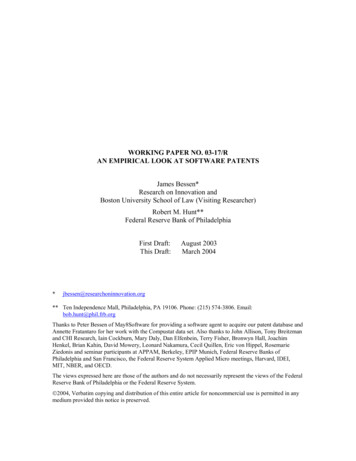
Transcription
WORKING PAPER NO. 03-17/RAN EMPIRICAL LOOK AT SOFTWARE PATENTSJames Bessen*Research on Innovation andBoston University School of Law (Visiting Researcher)Robert M. Hunt**Federal Reserve Bank of PhiladelphiaFirst Draft:This Draft:*August 2003March 2004jbessen@researchoninnovation.org** Ten Independence Mall, Philadelphia, PA 19106. Phone: (215) 574-3806. Email:bob.hunt@phil.frb.orgThanks to Peter Bessen of May8Software for providing a software agent to acquire our patent database andAnnette Fratantaro for her work with the Compustat data set. Also thanks to John Allison, Tony Breitzmanand CHI Research, Iain Cockburn, Mary Daly, Dan Elfenbein, Terry Fisher, Bronwyn Hall, JoachimHenkel, Brian Kahin, David Mowery, Leonard Nakamura, Cecil Quillen, Eric von Hippel, RosemarieZiedonis and seminar participants at APPAM, Berkeley, EPIP Munich, Federal Reserve Banks ofPhiladelphia and San Francisco, the Federal Reserve System Applied Micro meetings, Harvard, IDEI,MIT, NBER, and OECD.The views expressed here are those of the authors and do not necessarily represent the views of the FederalReserve Bank of Philadelphia or the Federal Reserve System. 2004, Verbatim copying and distribution of this entire article for noncommercial use is permitted in anymedium provided this notice is preserved.
AN EMPIRICAL LOOK AT SOFTWARE PATENTSJames BessenResearch on Innovation andBoston University School of Law (Visiting Researcher)Robert M. HuntFederal Reserve Bank of PhiladelphiaMarch 2004Abstract:U.S. legal changes have made it easier to obtain patents on inventions that use software.Software patents have grown rapidly and now comprise 15 percent of all patents. Theyare acquired primarily by large manufacturing firms in industries known for strategicpatenting; only 5 percent belong to software publishers. The very large increase insoftware patent propensity over time is not adequately explained by changes in R&Dinvestments, employment of computer programmers, or productivity growth. The residualincrease in patent propensity is consistent with a sizeable rise in the cost effectiveness ofsoftware patents during the 1990s. We find evidence that software patents substitute forR&D at the firm level; they are associated with lower R&D intensity. This result occursprimarily in industries known for strategic patenting and is difficult to reconcile with thetraditional incentive theory of patents.Keywords: Software, Patents, Innovation, Technological ChangeJEL classification: O34, D23, L86
IntroductionFederal courts, and to a lesser extent the U.S. Patent and Trademark Office (USPTO),dramatically changed standards for patenting software-related inventions over the lastthree decades. During the 1970s, federal court decisions typically described computerprograms as mathematical algorithms, which are unpatentable subject matter under U.S.law.1 Systems using software could be patented, but only if the novel aspects of theinvention did not reside entirely in the software.2 At this time, the U.S. Congressconsidered the question of patenting software and instead opted to protect computerprograms under copyright law.3But after the Supreme Court decision in Diamond v. Diehr in 1981,4 a series ofcourt and administrative decisions gradually relaxed the subject matter exception thatrestricted the patenting of software-related inventions. The 1994 decision In re Alapateliminated much of the remaining uncertainty over the patentability of computerprograms.5 During this same period, new legislation and other court decisions loweredstandards for obtaining patents in general, while strengthening aspects of patentenforcement.This paper explores the general characteristics of software patenting over the lasttwo decades, paying particular attention to the rapid growth in software patenting and theeffect of this growth on R&D. We construct our own definition of a software patent(there is no official definition) and assemble a comprehensive database of all suchpatents. In Section I we describe this process, and the process of matching these patentsto firm data in the Compustat database. In Section II we summarize the generalcharacteristics of this data. We find that over 20,000 software patents are now grantedeach year, comprising about 15 percent of all patents. Compared with other patents,1See, for example, the Supreme Court decision in Gottschalk v. Benson, 409 U.S. 63 (1972).Parker v. Flook 437 U.S. 584 (1978).3 U.S. Copyright law was amended in 1976, and more explicitly in 1980, to include computerprograms. See H. Rpt. No. 94-1476 (1976) and P.L. 96-517 (94 Stat 3028). There is a voluminousliterature on the merits of different forms of intellectual property protection for computer programs. See,for example, Dam (1995), Graham and Zerbe (1996), and Samuelson et al. (1994).4 450 U.S. 175 (1981).5 33 F.3d 1526 (Fed. Cir. 1994).23
software patents are more likely to be assigned to firms, especially larger U.S. firms, thanto individuals. They are also more likely to have U.S. inventors. Surprisingly, mostsoftware patents are assigned to manufacturing firms and relatively few are actuallyassigned to firms in the software publishing industry (SIC 7372). Most software patentsare acquired by firms in industries that are known to accumulate large patent portfoliosand to pursue patents for strategic reasons (computers, electrical equipment, andinstruments). These large inter-industry differences remain even after we control forR&D, software development effort, and other factors.In Section III we perform regressions that explore the “propensity to patent”software inventions. This builds on the model of Hall and Ziedonis (2001) which, in turn,builds on the empirical literature of “patent production functions” (including Scherer1965, Bound et al. 1984, Pakes and Griliches 1984, and Griliches, Hall, and Hausman1986). We find a dramatic growth in software patent propensity even after controlling forR&D, employment of computer programmers, and other factors. This growth is quitesimilar to the remarkable growth in patent propensity that Hall and Ziedonis (2001)found in the semiconductor industry. Productivity-based explanations are unlikely toaccount for even half of the rise in software patent propensity. The pattern of the residualincrease is consistent with the explanation that changes in patent law made softwarepatents significantly more cost effective. We also find that industries known for strategicpatenting have much higher patent propensities.Section IV explores the effect of software patenting on R&D. According to thetraditional incentive theory, making software patents more cost effective should increasethe profitability of firms that make software inventions. This, in turn, should induce themto increase their R&D spending. To test whether this in fact happened, we use a wellestablished empirical technique for estimating elasticities of factor substitution. We showthat the incentive hypothesis can be re-stated as the hypothesis that R&D and patents arecomplements. This means that increases in the appropriability of software should lead togreater R&D intensity. We find that this is not the case, however. Firms that increasedtheir software patenting relative to their overall level of patenting tended to decreasetheir R&D intensity relative to other firms. This result is robust to a variety of4
econometric and other considerations. But, again, this effect is concentrated in theindustries known for strategic patenting.In Section V, we note that while our empirical analysis does not identify thespecific causal mechanisms at work, these results are difficult to reconcile with thetraditional incentive hypothesis. Strategic patenting provides an explanation for a rise inpatent propensity together with an apparent substitution away from R&D: firms may beengaged in a patent “arms race.” The prominence of certain industries—known forstrategic patent behavior in other contexts—in our empirical results may not becoincidental. Section VI concludes.I.Background and DataA. Changing Legal Treatment and Strategic Patenting IndustriesThe erosion of the subject matter exception for computer programs occurred against abackdrop of broader changes in patent law following the creation of a unified appealscourt for patents suits in 1982 (see Hall and Ziedonis 2001, for a nice summary). Thecourt raised the evidentiary standards required to challenge patent validity and tended tobroaden the interpretation of patent scope (Rai 2003, Merges 1997). The court relaxedthe standards for evaluating whether or not an invention is obvious to practitioners skilledin the art (Cooley 1994, Dunner et al. 1995, Hunt 1999, Lunney 2001). The court wasalso more willing to grant preliminary injunctions to patentees (Cunningham 1995,Lanjouw and Lerner 2001) and to sustain large damage awards (Merges 1997, Kortumand Lerner 1999). Finally, plaintiff success rates in patent infringement suits haveincreased substantially (Lerner 1995).Some of these changes made patents “stronger,” in the sense that patents becamemore likely to be upheld in court or more effectively enforced. Others made patents“cheaper,” in the sense that lower patentability standards reduced the effort required toobtain a patent on a given invention. Together, these changes made patents more costeffective than before, generating more appropriability per dollar invested in obtaining andasserting them.5
If patents did become more cost effective, the change is likely greater for softwarethan for other inventions, for two reasons. First, the presumption that computer programscould not be patented was largely reversed by the mid-1990s. Second, a number of otherlegal decisions relaxed the “enablement” requirement for software patents. Under U.S.patent law, filers are required to provide detailed instructions explaining how theinvention works. It is supposed to be a “best mode” example of all of the patent claims.For software patents and business methods, it seems the courts have largely eliminatedthis requirement (Burk 2002, Burk and Lemley 2002).6 In the words of an IBM patentattorney, “[the patent standard] currently being applied in the U.S. invites the patenting ofideas that may have been visualized as desirable but have no foundation in terms of theresearch or development that may be required to enable their implementation” (Flynn,2001). The combined effect of these regulatory changes is that software patents appear tohave gained greater appropriability and became less costly to obtain in absolute termsover time and also possibly relative to other patents.Yet the software industry was highly innovative and growing rapidly well beforesoftware patents became commonplace. Nominal investment in software grew 16 percentper annum during the 80s (and 11 percent per annum during the 90s, Grimm and Parker2000). This innovativeness is important for two reasons. First, in interpreting resultsbelow, the growing use of software is an important factor. Second, given this history, it isnot at all clear that patent protection was essential for innovation in this industry.This is not unusual. When surveyed, American firms in a number of otherinnovative industries (including semiconductors and precision instruments) rate patentsas a relatively less effective form of appropriability (Levin et al. 1987, Cohen, Nelson,and Walsh 2000). Instead, they cite lead time advantages, learning curves,complementary sales and service and secrecy as generally more important sources ofappropriability.6 Reviewing case law, Burk and Lemley (2002, p. 1162) write: “For software patents, however, a seriesof recent Federal Circuit decisions has all but eliminated the enablement and best mode requirements. Inrecent years, the Federal Circuit has held that software patents need not disclose source or object code,flow charts, or detailed descriptions of the patented program. Rather, the court has found high-levelfunctional description sufficient to satisfy both the enablement and best mode doctrines.” See also Cohenand Lemley (2001) on the different treatment of software patents.6
Yet even in industries where patents are rated as ineffective, we sometimesobserve that firms sometimes acquire large patent portfolios. These industries, includingthe computer, electrical equipment and instruments industries, are also found to accountfor a major share of the growth in patenting in recent years (Hall 2003). Some researchershave suggested that firms in these industries may patent heavily in order to obtainstrategic advantages, including advantages in negotiations, cross-licensing, blockingcompetitors, and preventing suits (Levin et al. 1987, fn 29, and Cohen, Nelson, andWalsh 2000). In principle, strategic patenting can arise whenever individual productsinvolve many patentable inventions and the cost of obtaining patents is sufficiently low(see Bessen 2003 for a theoretical model). Firms may acquire large numbers of patents sothat even if they have an unsuccessful product, they can hold up rivals, threateninglitigation. Innovative firms may acquire “defensive” patent portfolios to make a crediblecounter-threat. The outcome may involve the cross-licensing of whole portfolios, wherefirms agree not to sue each other and those firms with weaker portfolios pay royalties(Grindley and Teece 1997).So, in what follows, it is natural for us to be alert to the possibility that softwarepatents may also be acquired for strategic purposes and we will find distinctive behaviorin the industries known for strategic patenting. An important implication of strategicpatenting is that policy changes that “strengthen” patents (or make them cheaper toacquire) can lead to a kind of “Prisoner’s Dilemma” game that actually decreases theprivate incentive to engage in R&D.B. What Is a Software Patent?How many software patents are being granted? Although the patent office maintains asystem for classifying patents, this system does not distinguish whether the underlyingtechnology is software or something else. Researchers must construct their owndefinitions.Some observers have sought to identify “pure” software patents where theinvention is completely embodied in software (e.g. Allison and Lemley 2000). We prefernot to use such a definition for two reasons. First, beginning with Diamond v. Diehr,7
attorneys have drafted software patents in such a way that they did not necessarily appearto be patents on software.7 This makes the determination of a “pure” software patentsomewhat arbitrary and impractical for a comprehensive database. Second, we do notnecessarily assume that the subject matter exclusion is the only difference betweensoftware patents and other patents. For example, we noted above that software patents aresubject to a different “enablement” requirement. So it is useful to study a somewhatbroader range of patents in any case.Our concept of software patent involves a logic algorithm for processing data thatis implemented via stored instructions; that is, the logic is not “hard-wired.” Theseinstructions could reside on a disk or other storage medium or they could be stored in“firmware,” that is, a read-only memory, as is typical of embedded software. But we wantto exclude inventions that involve only off-the-shelf software—that is, the software mustbe at least novel in the sense of needing to be custom-coded, if not actually meeting thepatent office standard for novelty.1. Identifying software patentsHow can we identify patents that fit this description? Griliches (1990) reviews the twomain techniques that researchers have used to assign patents to an industry or technologyfield: 1) using the patent classification system developed by the patent office; and 2)reading and classifying individual patents. In this paper, we use a modification of thesecond technique.We began by reading a random sample of patents, classifying them according toour definition of software, and identified some common features of these patents. Weused these to construct a search algorithm to identify patents that met our criteria. Weused this algorithm to perform a keyword search of the U.S. Patent Office database,which identified 130,650 software patents granted in the years 1976 to 1999. Next, to7 For instance, Cohen and Lemley (2001, p. 9) argue “The Diehr decision and its appellate progenycreated what might be termed ‘the doctrine of the magic words.’ Under this approach, software waspatentable subject matter, but only if the applicant recited the magic words and pretended that she waspatenting something else entirely.” In Diamond v. Diehr, the Supreme Court ruled that an invention usingtemperature sensors and a computer program to calculate the correct curing time in an otherwise8
validate the accuracy of this algorithm, we compared the results of our search against arandom sample of 400 patents which we had read and classified into software patents andother patents. We also compared our results to samples and statistics generated by otherresearchers. The details of the algorithm and characteristics of the sample are describedin the Appendix.Compared to our random sample of 400 patents, this algorithm had a falsepositive rate of 16 percent (that is, 16 percent of the patents the algorithm said weresoftware patents, were not) and a false negative rate of 22 percent (that is, it failed toidentify 22 percent of the patents we categorized as software patents).We performed a number of other checks. First, we compared our list of softwarepatents to a set of 330 software and Internet patents identified in research conducted forthe papers by Allison and Lemley (2000) and Allison and Tiller (2003).8 These patentswere identified by reading a larger number of patents, but applying a more narrowdefinition of software inventions (again, where the invention is completely embodied insoftware).9 Virtually all (92 percent) of the software patents identified by Allison werecategorized as software patents by our algorithm. Thus our false negative rate for “pure”software patents appears to be quite small (8 percent). Second, using statistics generatedby the research in Allison and Lemley (2000), we calculated an upper bound on thecomparable false positive rate of 26 percent.10 Given that we are using a broaderdefinition of software patent, it is reassuring to find that this number is not much largerconventional process of molding rubber goods could be patented. We treat this as a software patent;Allison and Lemley would not.8 Thanks to John Allison for sharing his data with us. The data used in Allison and Lemley (2000) arebased on reading 1,000 randomly selected patents issued between mid 1996 and mid 1998. That data wasaugmented in Allison and Tiller (2003) by examining 2,800 patents issued between 1990 and 1999identified via a keyword search (for the terms Internet or world wide web) restricted to patents included inclasses 705, 707, or 709. Note that in the Allison and Tiller taxonomy, internet business method patents area subset of software patents.9 Both papers state the following: “Another researcher might include within the Software classificationthose inventions in which the algorithms are embodied in chips, but we have chosen to include within ourdefinition of Software only those inventions that consist purely of software that is not embodied inhardware.”10 Allison reports identifying 92 pure software patents in the sample of 1,000 evaluated in that paper(private communication). This is somewhat higher than the 76 reported in the published version of thepaper. For the same years, the ratio of software patents to total patents calculated using our algorithm was11.5%. Thus an upper bound on the false positive rate is (.115-.092*.92)/.115 26%.9
than the false positive rate generated when using our own random sample. Although thealgorithm does make errors, it performs reasonably well, and it seems unlikely that itintroduces significant biases to our patent counts or regression coefficients.2. Using Patent Classes to Identify Software InventionsWhy did we use this rather laborious method rather than simply counting patents incertain patent classifications? First, in a longitudinal study patent classes are problematicbecause the classification system changes over time and the patent office continually reclassifies issued patents. Moreover, lawyers are known to draft patents so that they avoidfalling into certain classes in order to influence the examiner’s prior art search or someother aspects of the examination (Lerner 2004, p. 19).Second, economists have long recognized the poor correspondence betweenpatent classes and economic concepts of industry or technology (see, for example,Schmookler 1966, Scherer 1982a, Scherer 1984, Soete 1983, and Griliches 1990). Patentclasses are not designed with social scientists in mind but are used primarily to aid priorart search. Although patent classes can be used effectively when they are confined toselect sets of well-defined subclasses (e.g., Schmookler 1966, Lerner 2004), or whenclassifications are statistically distributed over industries (e.g., Silverman 1999), or whentaken as loosely representative (e.g., Graham and Mowery 2003), a definition based onpatent classes is likely to introduce significantly more inaccuracies than the approachchosen in this paper.11In the case of the U.S. classification system, there are no patent classes forsoftware per se. Instead, software inventions are included in functional categories alongwith hardware inventions. For instance, one class includes “arrangements for producing apermanent visual representation of output data.” This is a functional description that11 Allison and Lemley (2000) and Allison and Tiller (2003) also reject the idea of using patentclassifications to identify software patents. According to Griliches (1990), a patent class is “basedprimarily on technological and functional principles and is only rarely related to economists’ notions ofproducts or well-defined industries (which may be a mirage anyway). A subclass dealing with thedispensing of liquids contains both a patent for a water pistol and for a holy water dispenser. Anothersubclass relating to the dispensing of solids contains patents on both manure spreaders and toothpastetubes” (Griliches 1990, p. 1666).10
includes software programs, hardware computer displays, and even electric andmechanical signs that pre-date electronic computers.Still, we did examine the efficacy of using the patent classification approach foridentifying software inventions, as proposed in Graham and Mowery (2003). In thatpaper, the authors identified a number of subdivisions of the International PatentClassification system (IPC) where many patents assigned to large U.S. softwarecompanies may be found.12 We compared the list of software patents identified by thisapproach with our random sample of 400 patents. The results were significantly worsethan our own algorithm: a 30 percent false positive rate and a 74 percent false negativerate. We also found that this definition would exclude half of the patents obtained by thetop 200 publicly-traded software firms during the 1990s, and a majority of the puresoftware and Internet patents identified in Allison and Tiller (2003). In contrast, ourdefinition accounts for about 4/5 of all patents obtained by the top 200 software firms inthe 1990s.Nevertheless, to check whether our main results were robust to our choice ofalgorithm, we ran most of our tabular analyses and regressions below using the GrahamMowery definition of software patent. Although standard errors were predictably higher,the results were broadly similar. For example, the distribution across industries wassimilar and patents and R&D were found to be statistically significant substitutes.Although Graham and Mowery’s approach is useful for obtaining a rough impression, itis not the best technique for a more comprehensive study such as ours, and attempts toimprove its coverage by adding more classes are likely to increase the false positive rate.To summarize, our algorithm has a positive error rate. For this reason, one canfind patents that our algorithm incorrectly classifies as software patents (see Hahn andWallsten 2003). But the rate of false positives is reasonably low and the algorithmappears to be substantially more accurate than at least one alternative based on patentclasses. Moreover, the evidence suggests that there is no systematic bias in these errors:our main results hold even when we use a very different definition of software patent.12The subdivisions include G06F 3/, 5/, 7/, 9/, 11/, 13/, and 15/; G06K 9/, and 15/; and H04L 9/.11
C. The Matched SampleWe also explore the characteristics of the firms that obtained software patents and, inparticular, the relationship between software patenting behavior and firm R&Dperformance. To do this, we matched a large portion of both software patents and otherpatents to firms in the 1999 vintage of the Compustat database.Our main population of interest consists of U.S.-owned public firms that performR&D. This group performs a large share of domestic R&D and it should provide arelatively stable group for comparison over time. But it does limit the relevance of ourconclusions to this group, however, and so our analysis has little to say about start-upfirms, individuals, universities, etc.We begin by matching our patents to firms (i.e. the assignees) using the NBERPatent Citations Data File (Hall, Jaffe and Trajtenberg 2001a).13 This data set matchespatents to the 1989 vintage of firms contained in Compustat, so we do a variety of thingsto supplement those matches:1. We added the largest 25 publicly traded software firms ranked by sales (onlyone of which is included in the NBER file).2. We merged the data set with a set of firm-patent matches provided to us byCHI Research.14 That data encompasses most of the significant patentingfirms (public or private) over the last 25 years.3. Using data contained in Compustat, we identified 100 of the largest R&Dperformers in 1999 that were not already included in our data set. We matchedthese firms and their subsidiaries to their patents using a keyword search onthe USPTO web site.13To be precise, we match patent numbers in our data set with those found in the NBER data set.Where available, we use the firm CUSIP assigned by NBER to obtain financial data from Compustat.14 We again match by patent number and use the firm CUSIP assigned by CHI. Details on CHI’sproprietary data is described at patdata.php3. We aregrateful to Tony Breitzman for sharing this data with us.12
The final file held 4,792 distinct subsidiaries and 2,043 parent firms from 1980 to 1999,an improvement of 1,230 subsidiaries and 305 firms over the NBER database for thesame period.15To test the coverage of this matched sample, we compared it to the targetpopulation in Compustat (that is, all U.S. firms that publicly report financials withpositive R&D). The matched sample performed 91 percent of the deflated R&D in theCompustat file over this period and accounted for 89 percent of the deflated sales byR&D-performing firms. Moreover, the coverage ratios are roughly constant over theentire sample period, varying only a few percentage points in each direction over twodecades. Over this period, the matched sample also accounts for 68 percent of allsuccessful U.S. patent applications by domestic non-government organizations (mostlycorporations) and 73 percent of software patents granted to these organizations. Thesecoverage ratios were also quite stable over the two decades.However, only 37 percent of the R&D-performing firms contained in Compustatare matched to their patents in our data set and this coverage declined over the sampleperiod as an increasing number of small firms have gone public since 1980. Thus thismatched sample is broadly representative of the firms that perform most of the R&D andobtain the majority of patents, but it is not representative of entrants and very small firms.Nevertheless, given the extent of our coverage of R&D and patents, the results we obtainin our sample regarding patents and R&D will represent the overall interaction betweenpatents and R&D.It is possible that sample selection may bias regression coefficients within thematched sample. To check for this, we implement Heckman two-stage sample selectionmodels (below) and find, in general, that sample selection has little effect.D. Other dataWe used the NBER Patent Citations Data File (Hall, Jaffe and Trajtenberg 2001a) toobtain data on citations received and numbers of claims. To obtain data on employment15The original NBER sample accounted for 47% of the successful patent applications to U.S. nongovernment organizations; our sample accounts for 68% of these patents.13
of programmers and engineers, we used the Occupational Employment Survey conductedby the BLS. This source provides detailed occupational employment of 3 digit SICindustries. Because not all industries were covered in all years of the survey during theearly years, we linearly interpolated employment shares.16 We also use a number of inputprice indices from the BLS Multifactor Productivity series.Summary StatisticsII.Table 1 reports the number of software patents and other patents granted per year andalso the numbers of applications per year, conditional on the applications successfullyresulting in a grant by the end of 1999. As can be seen, their numbers have growndramatically in absolute terms and also relative to other patents. Today almost 15 percentof all patents granted are software patents.Table 1 also shows estimates of the number of software patents published by GregAharonian.17 The overall trends are quite similar and the numbers in recent years are alsoquite close. Clearly, our definition of software patents is more inclus
bob.hunt@phil.frb.org Thanks to Peter Bessen of May8Software for providing a software agent to acquire our patent database and Annette Fratantaro for her work with the Compustat data set. Also thanks to John Allison, Tony Breitzman and CHI Research, Iain Cockburn, Mary Daly, Dan Elfenbein, Terry Fisher, Bronwyn Hall, Joachim Henkel, Brian Kahin, David Mowery, Leonard Nakamura, Cecil Quillen .




